Physical Address
304 North Cardinal St.
Dorchester Center, MA 02124
![]() Access the accompanying videos for this chapter online. Available on ExpertConsult.com .
Access the accompanying videos for this chapter online. Available on ExpertConsult.com .
Empyema thoracis is a collection of inflammatory fluid in the thoracic cavity. It usually arises as a complication of pneumonia, but it may also result from trauma, subdiaphragmatic infections, immunodeficient conditions, neoplastic processes, and other inflammatory states. Empyema formation annually occurs in 2% to 8% of children hospitalized for pneumonias. The progression of empyema is described in three stages: exudative, fibrinopurulent, and organizing. The exudative stage is characterized by sterile, thin fluid with minimal debris. The pH and glucose levels of the fluid are normal and the lactate dehydrogenase (LDH) level is low. The fibrinopurulent stage has thicker fluid, thick fibrin strands, loculations, and bacterial contamination. The pH and glucose levels are low and the LDH level begins to increase. A fibrinous peel develops, which restricts lung expansion. Finally, the pleural infection can progress to the organizing stage in which a thick fibrous peel can encase the lung, leading to compromised lung expansion. It usually takes 4 to 6 weeks for this stage to develop.
Debridement refers to the removal of semisolid debris from the thoracic cavity. Decortication is the removal of the solid thick peel that may line either the parietal or visceral pleura (or both). The goals of thoracoscopic debridement and decortication for empyema are to drain the infectious fluid from the pleural cavity and release the entrapped lung, to hasten resolution of symptoms, and to prevent pleural scarring.
Since the introduction of routine vaccination for Haemophilus influenzae, the most common causative organisms for childhood pneumonias are Streptococcus pneumoniae and Staphylococcus aureus . Most patients have received a course of oral antibiotics before presentation. Symptoms can range in severity. High spiking fevers, pleuritic chest pain, hypoxia, and a leukocytosis are suggestive of an empyema.
The chest radiograph usually reveals haziness or opacification of a portion of the involved hemithorax. A lateral decubitus chest film may reveal layering of fluid. A chest ultrasound (US) or a computed tomography (CT) scan is a good diagnostic test to gauge the thickness of the fluid or to determine whether it is loculated ( Fig. 34-1 ). The US is preferred due to the lack of ionizing radiation to the patient. Thin parapneumonic fluid collections with minimal fibrinous debris (the exudative stage) may be drained with a chest tube/catheter. Patients with loculated fluid or fluid with thicker fibrin strands (the fibrinopurulent stage) are the best candidates for fibrinolytic therapy or thoracoscopic debridement/decortication. Patients who fail to improve clinically in 48 to 72 hours with simple chest tube drainage should be considered for fibrinolysis or thoracoscopic debridement/decortication. If the presence of a thick, solid peel encasing the lung is suggested on US or CT, the surgeon can start with thoracoscopy but must be prepared for an open debridement/decortication.

In the past 10 years, fibrinolytic therapy has been found to be as efficacious as thoracoscopic debridement/decortication as initial therapy for stage 2 empyema. In 2009, our group at Children’s Mercy reported a prospective randomized trial comparing thoracoscopic debridement/decortication with intrapleural fibrinolysis using tissue plasminogen activator (tPA). In that study, there were no therapeutic or recovery advantages between the thoracoscopic debridement/decortication and fibrinolytic therapy. However, the hospital charges were much greater with thoracoscopy. Our group concluded that fibrinolysis should be the initial therapy for children with empyema. Similar findings were found in a prospective randomized trial from colleagues at Great Ormond Street who used urokinase as opposed to tPA. In both studies, the failure rate for fibrinolysis was 16%, which indicated that around 85% of children with a loculated empyema can avoid an operation. Our current management of children at Children’s Mercy Hospital who present with empyema is shown in Figure 34-2 .
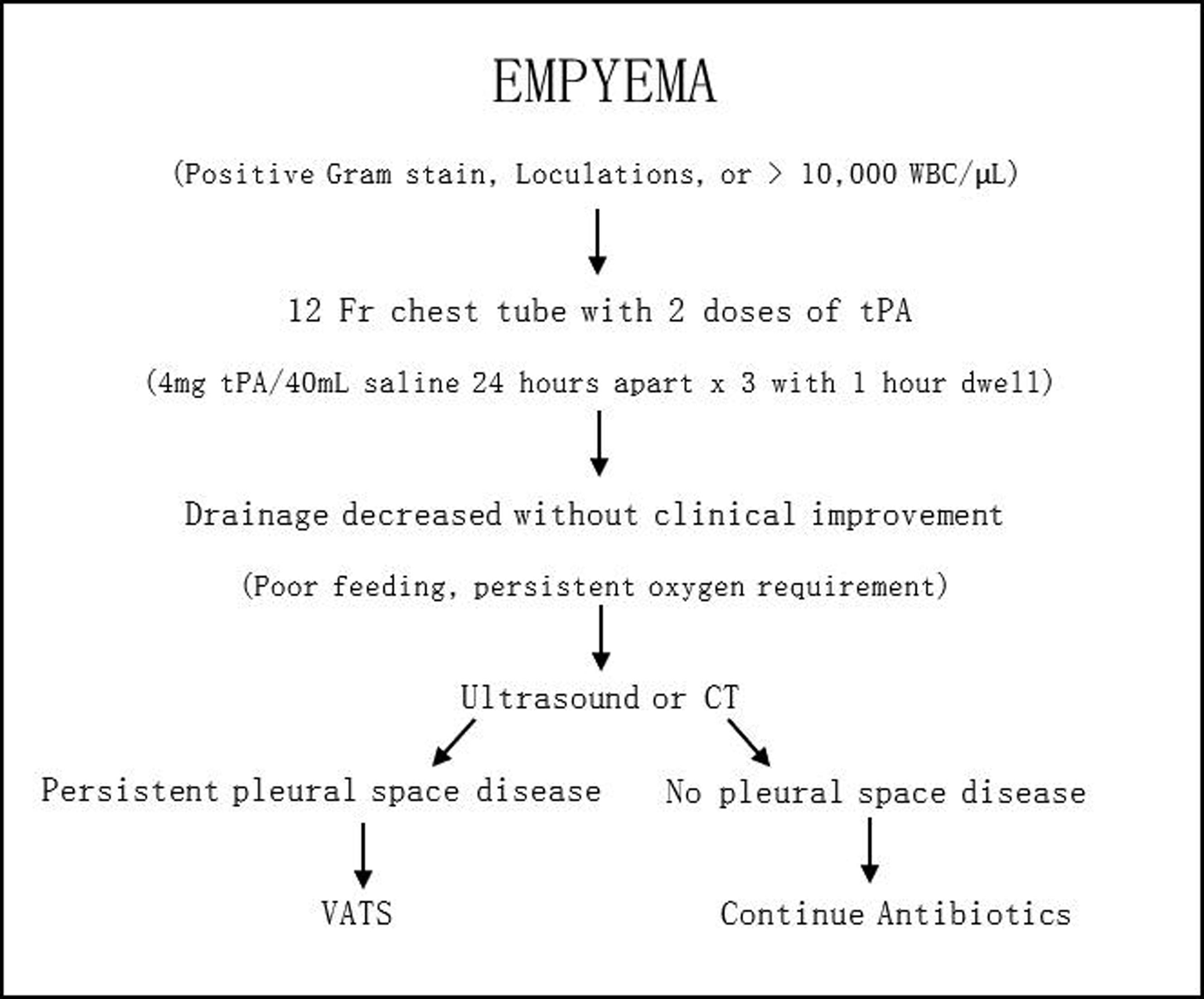
Despite these findings, it seems that the pediatric surgery community remains divided on best practice as it pertains to the initial treatment of the child who has an empyema. The initial treatment today appears to be dictated by one’s personal experience and training, one’s hospital’s traditional practice, and data from retrospective reports. The following discussion about operative technique and postoperative care will pertain to those patients who either undergo thoracoscopic debridement/decortication initially or fail initial fibrinolytic therapy.
When indicated, thoracoscopic debridement/decortication is performed under general anesthesia with endotracheal intubation. If possible, single-lung ventilation using a double-lumen endotracheal tube is employed. The use of invasive monitoring devices such as an arterial line or central venous monitoring is left to the discretion of the anesthesiologist and usually depends on the severity of the patient’s illness.
The patient is positioned in the lateral decubitus position with the affected side up. An axillary roll is placed ( Fig. 34-3 ). A smaller child may need another roll at the waist to support the lower back and help enlarge the intercostal spaces for access to the pleural cavity. The larger child may need to be positioned on the iliac crest rests at the break in the operating table to open the intercostal spaces. Pressure points such as the proximal fibula, ankle, and foot should be protected with foam pads or lambskin. The arms are best bent at the elbow with the hands directed cephalad. The surgeon and assistant stand opposite one another, with the scrub nurse to the surgeon’s right. Two video monitors are helpful as the operation is usually performed in all parts of the thoracic cavity (see Fig. 34-3 ). One monitor should be positioned at the foot of the operating table and one at the head of the table.
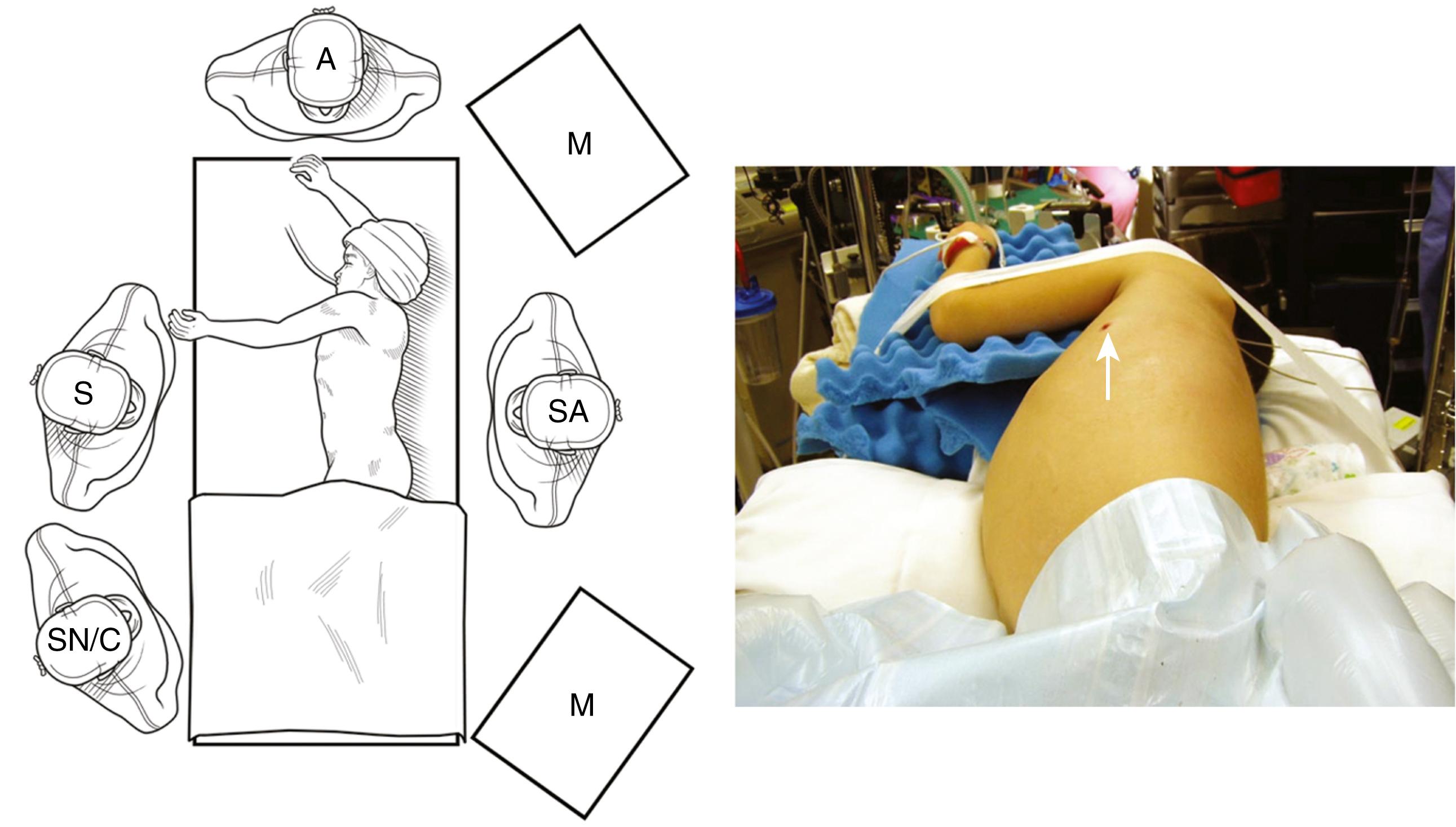
Almost all empyemas affect the caudal portion of the thoracic cavity. Initial access to the empyema can be gained through a 10-mm incision in the anterior axillary line at the level of the fourth or fifth intercostal space ( Fig. 34-4 ). A 10-mm valved cannula with a blunt tip is then introduced through this incision and into the thoracic cavity. Valved cannulas are used initially to allow positive-pressure insufflation up to 10 mm Hg to help compress the lung and create a working space within the rigid thoracic cage. Alternatively, if a chest tube was previously placed, this site can be used for insertion of the initial port. After removal of the chest tube, the 10-mm cannula is inserted through this established tract.
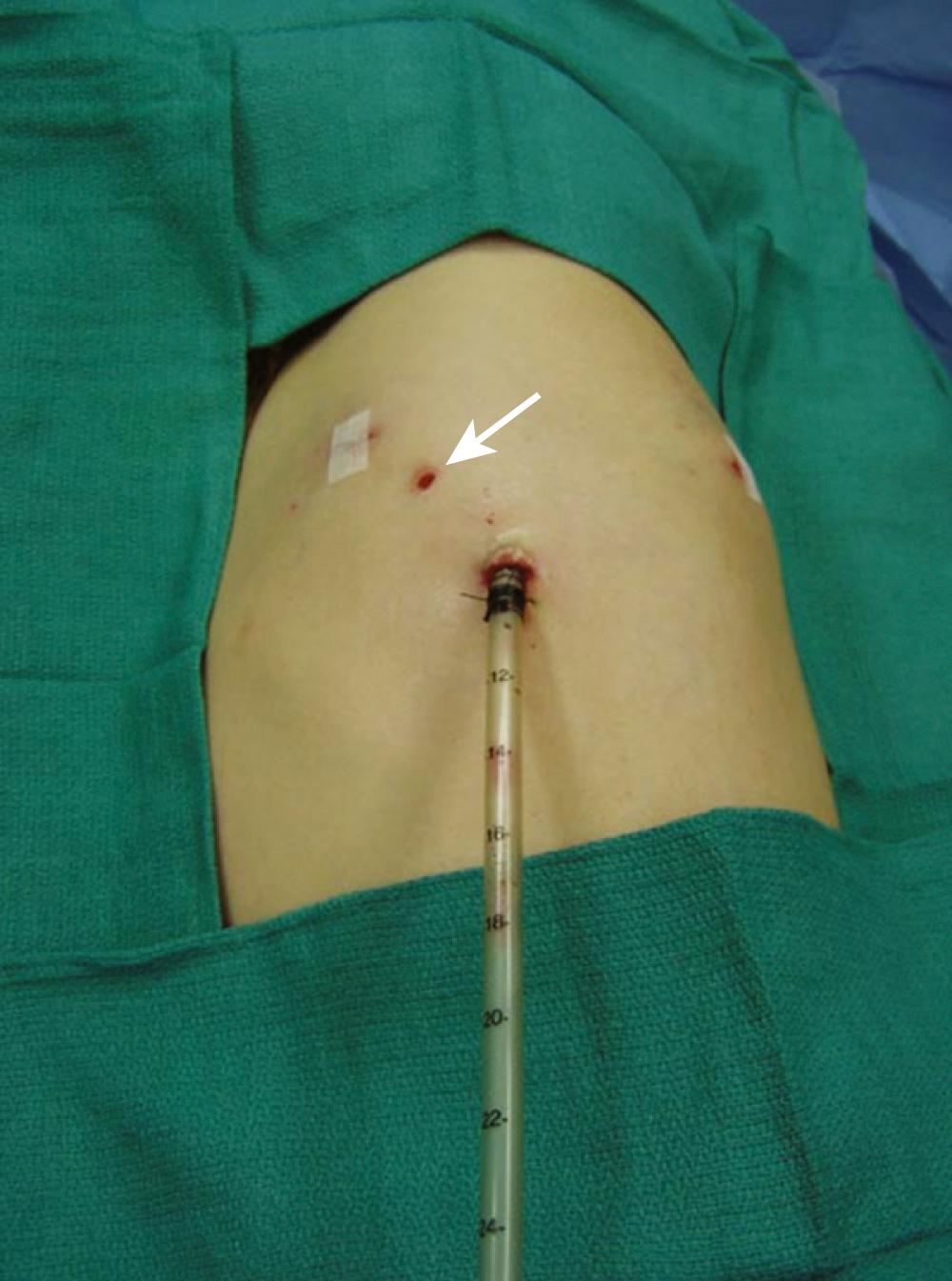
Following introduction of this initial cannula, a 10-mm angled telescope is introduced through the cannula and is used to further create a working space by sweeping the adhesions and compressing the lung away from the chest wall. Once the underlying lung has been freed and a working space created, a second 10-mm incision is made and a cannula is inserted into the same interspace in the posterior axillary line. The third incision and cannula are positioned in the midaxillary line in the 9th or 10th intercostal space (see Fig. 34-4 ). This incision will be the site for exteriorization of the chest tube after completion of the thoracoscopic debridement/decortication. With this arrangement, a working triangle is formed.
Initially, a suction device is used to evacuate the thoracic cavity of its liquid contents. The pleural fluid is sent for Gram stain and culture. The fibrinous material is debrided from the visceral and parietal pleural surfaces using atraumatic blunt-tipped endoscopic forceps. Once the lung is collapsed and an adequate working space is achieved, the cannulas can be removed and curved ring forceps introduced directly through the chest wall incisions to debride the pleural space ( Fig. 34-5 ). Depending on which portion of the thoracic cavity is being debrided, the instruments and telescope are rotated between the three incisions to triangulate the area being addressed. The surgeon must be careful to avoid lung injury when performing the debridement. All pockets of fluid should be drained as completely as possible. At the conclusion of the operation, the chest cavity is irrigated with warm saline.
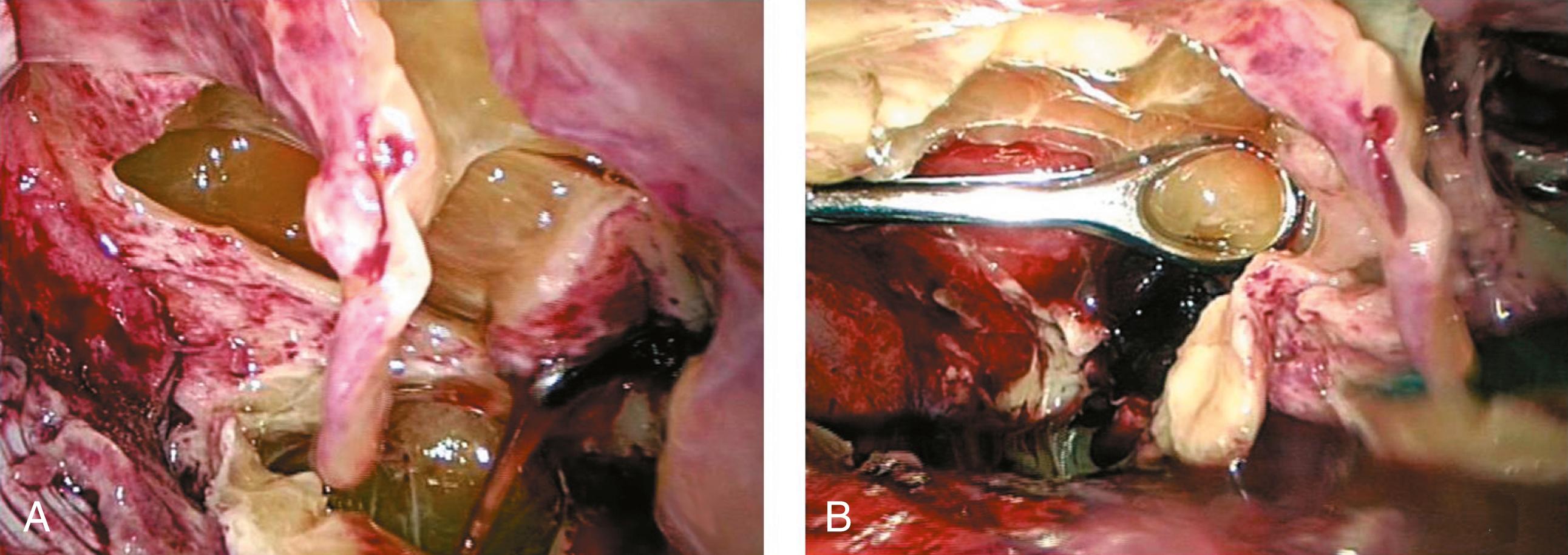
A single chest tube (usually 24 or 28 Fr depending on the child’s size) is inserted into the pleural space under thoracoscopic visualization ( Fig. 34-6 ). Typically, the most inferior port site is used as the exit site, with the tube directed posteriorly within the chest cavity. The tube is inserted through this most inferior incision but is then tunneled over the cephalad rib to create a soft tissue tract and help prevent the development of a pneumothorax when the chest tube is removed. The incisions are closed in layers with absorbable suture. The chest tube is placed under −10 to −20 cm H 2 O suction, depending on the size of the child.
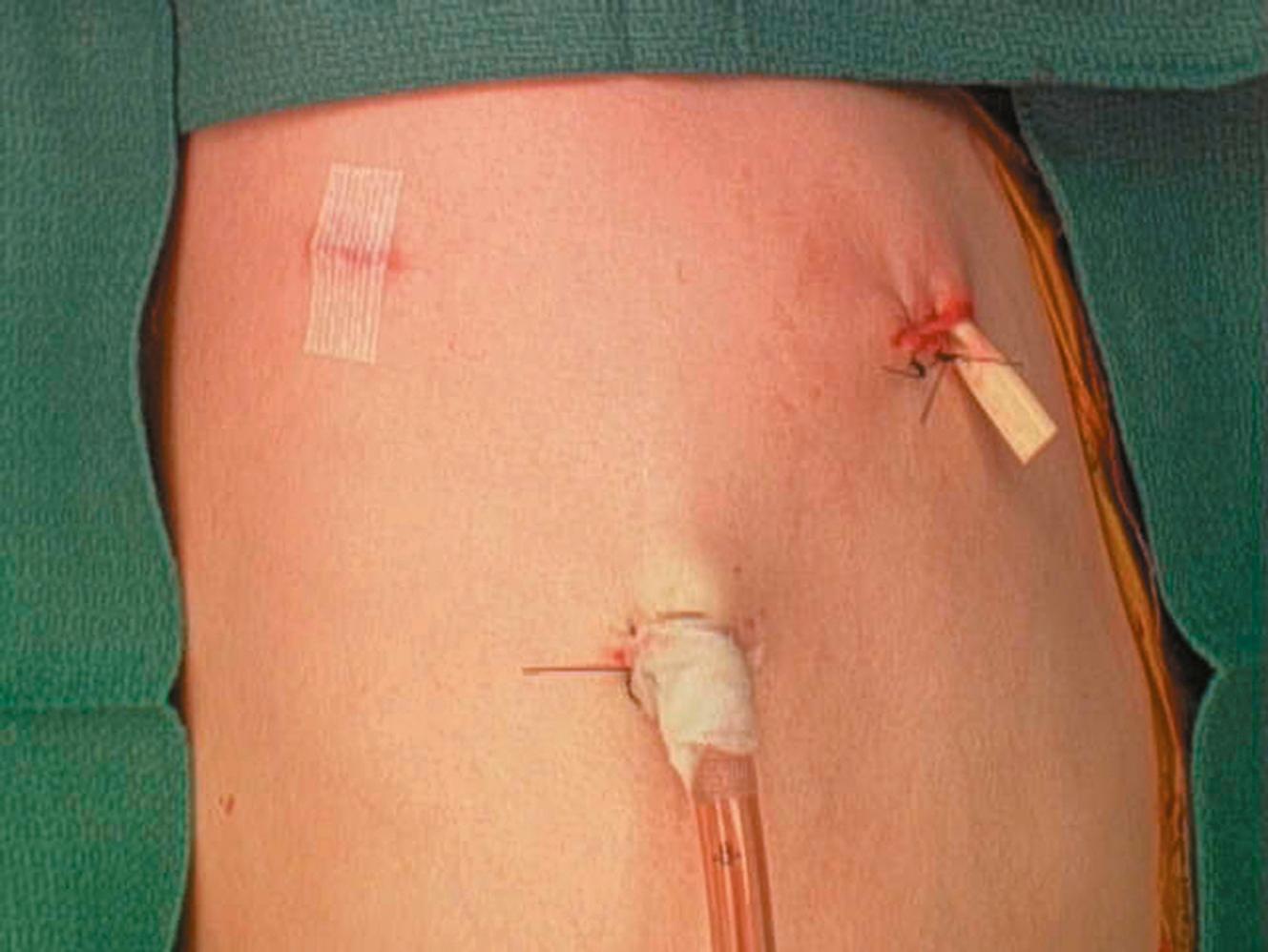
Become a Clinical Tree membership for Full access and enjoy Unlimited articles
If you are a member. Log in here